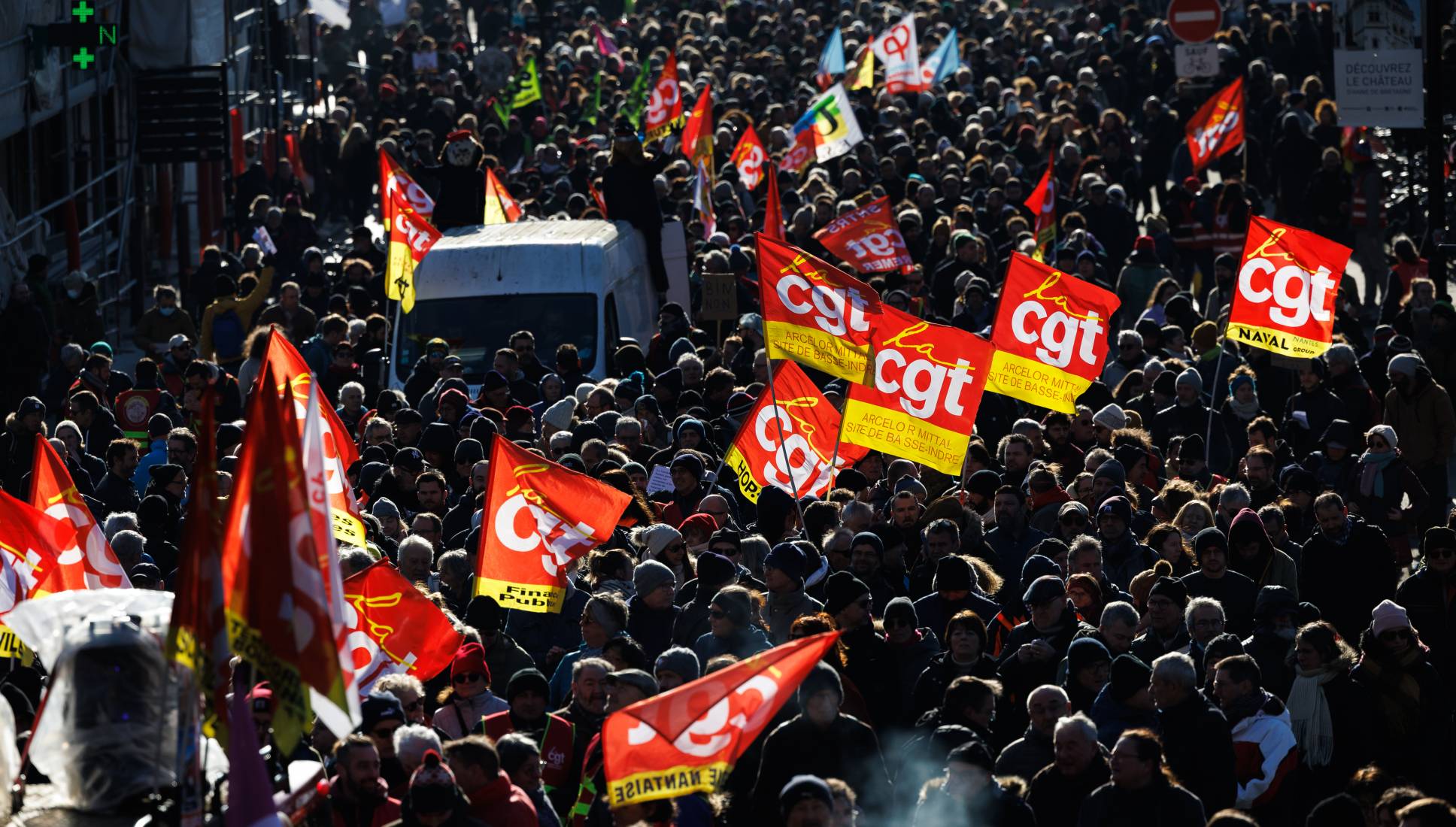Menu
Just Transition Insights, Issue #20, 08/28/2023
By Jonathan Tasini
|

[Editorial note: A reminder that we are publishing on a monthly basis during the U.S. summer months, returning to our regular schedule in September]
Leading Off: French Auto Workers Ask—What Is The Future For The Car?
[On May 24th, a gathering took place in France, bringing together the main French workers federation, the Confédération Générale du Travail (CGT—General Confederation of Labour), and a group of environmental NGOs to attempt to find common ground on the issues of Just Transition. We have translated, as closely as possible, the lion’s share of the report from the important meeting]
On May 24, a forum on the future of the automobile took place in Montreuil, organized by the Federation of Metallurgy Workers CGT, Réseau Action Climat and Greenpeace France.
With more than 350 union or association activists gathered on the patio of the CGT house, this unprecedented initiative was a great success. The debates, after an intervention by Sophie Binet, were very rich. The presentations and discussions of the forum will soon be available online.
Our organizations are convinced of the need to work together in order to reconcile social, environmental, economic and health issues. They share the feeling of climate urgency and that it is inconceivable that greenwashing serves as a pretext for social destruction. Many speakers also denounced the industrial strategies of employers and governments based on a purely financial vision, the relocations, the closures of companies suffered by a large number of employees. This forum allowed us to reaffirm our common disagreement with the political decisions and strategic choices of manufacturers.
By targeting only wealthy households to optimize their margins, by producing ever heavier and ever more expensive vehicles, by re-importing vehicles from China (such as the Dacia Spring) which is one of the most carbon-intensive countries in the world, manufacturers are a heavy responsibility for global warming.
This forum allowed us to demonstrate that it is possible to produce in France a small electric vehicle accessible to all.
We wanted to promote our convergences and focus on what brings us together, but without erasing the culture of debate that our organizations share. Thus, during this forum we also debated on the energy mix and the place of the heat engine in the automotive industry by assuming our differences.
Which vehicles for tomorrow?
The CGT proposals The urban vehicles par excellence are the bicycle, the bus, the tram, the metro. Not the car. But for families who do not live in the centers of large cities and cannot make their daily trips on foot or by metro, the car is essential.
The CGT is not in favor of abandoning the thermal engine: to make long journeys in electric mode, you need a battery 3 or 4 times more expensive and heavier, and for its manufacture you need 3 or 4 times more raw materials and CO2 emissions compared to a battery sized for daily use.
If it is to make two trips a year, it is a social and environmental aberration. According to the formula of a Renault expert, it’s like investing in a 12-place dishwasher for Christmas.
A wealthy household makes 8 trips a year, a modest household only 2, and it is often to go with the family. The solutions are not the same. For sustainable mobility to be accessible to all, solutions are needed that are adapted to everyone’s uses, not just those of wealthy households.
The CGT defends an energy mix scenario:
- For the 2nd cars (≈ 35% of the fleet), inexpensive electric vehicles for daily use, with small batteries (≈20 kWh) whose additional cost would be easily offset by fuel savings, to repay a loan to zero rate at 100€ per month.
- Rechargeable hybrids (Plug-in Hybrid Electric):(about 45% of the fleet), inexpensively, which can drive 100% electric on a daily basis, and with electricity provided by a small auxiliary heat engine for a few long journeys per year. Unlike NGOs like T&E, we do not generalize to other users the finding of the essentially thermal use of their PHEVs, that in make today’s high-rolling executives.
- Electric vehicles with large batteries (> 60 kWh) suitable for long journeys (about 20% of the fleet, making 50% of long journeys) for households that make a lot of long journeys, mainly wealthy households. The economic and environmental entry ticket of the batteries is then better amortized over a long mileage. And low family cars replacing the current large SUVs, with little or no public aid.
The best solution to reduce CO2 emissions is a mix of electric motors and combustion engines, adapted to the needs and means of all households.
In this scenario, there is no thermal driving in town. Only 10% of the rolling stock remains in thermals, on part of the long journeys outside major cities. The current production of biofuels is then largely sufficient. In the end, 0% fossil fuel in this scenario is realistic well before 2035.
Compared to 100% electric, there is no comparison: this scenario makes it possible to divide the cumulative quantity of batteries by 2, to avoid the extraction of around 100,000 tonnes of lithium or cobalt for the French fleet alone, is the current world production. In this scenario, where there is one internal combustion engine in nearly one in two vehicles, CO2 emissions are 20% lower than in the European Commission’s all-electric scenario. The future will show, with a little more evidence each year between now and 2035, that the scenario of the European Commission leads to a dead end. It’s just a matter of time.
It is possible to produce small electric vehicles popular in France.
Prototypes have been made by engineers at Renault and Stellantis, but management is targeting wealthy households and high-margin SUVs and has not followed through. Vehicles of this type, the “kei-car”, such as the Nissan Sakura (17k€, dimensions of a 4L), exist in Japan. The Sakura platform is supposed to be common with Renault, so there is little investment. It is only a matter of political will.
The CGT and environmental NGOs share this priority and have decided to act together to influence the policy of builders.
It is also possible to produce affordable PHEVs, at less than 25k€. In principle, these are basically electric vehicles with a small booster motor and an additional electricity generator. Prototype heat engines for this type of application exist, such as the ULCGE, which Renault has not followed up on, or the ZVG from Obrist. For solutions, CEOs just have to ask their engineers and listen!
SPONSOR MESSAGE
A message from the Australian Mining And Energy Union
We are fighting back, not just for ourselves but for the future generation of mineworkers. Workers deserve better. Our families and communities deserve better. Visit us

Spotlight: Slave Labor In Solar
We have pointed out repeatedly in this newsletter the fundamental problem in the idea of “Just Transition”, as the term is generally used, especially when it comes to the future “green industries”: you cannot be considering a “high bar” Just Transition if there is an absence of strong collective bargaining, and, certainly, if the labor market is awash in slave/forced labor. There are far too many government officials, environmental advocates and company leaders who put forward the future “green industries” as the panacea for the millions of workers in fossil fuel-related work who will need to find a new job.
To wit:
First Solar, a leading U.S. solar panel manufacturer, said on Tuesday that an audit had found that migrant workers in its operations in Malaysia were victims of forced labor.
The independent audit, which was included in a corporate sustainability report, found that four subcontractors in Malaysia had charged the workers recruitment fees in their home countries and withheld their pay and passports.
U.S. officials and human rights activists have become increasingly concerned about the use of forced labor in the manufacture of solar panels, most of which takes place in Asia.
Global supply chains for solar panels have for years relied on China, in particular for polysilicon, a crucial component in most solar panels made around the world. But a recent ban on products from Xinjiang, a region where the U.S. government and United Nations accuse the Chinese government of committing human rights violations, including forced labor, has led to a shift away from China.
If you want to take at face value that First Solar didn’t know the nature of its supply chains—in other words, that forced labor was a central component—we have, as the saying goes, beachfront property on offer in the swamplands of Florida. It doesn’t pass the smell test.
However, at the very least, this is gross corporate negligence and is almost certainly not a one-off.
It is just a fact that 95 percent of the new “green” industry jobs are in non-union environments, which, just based on pure economic data over the past half century comparing union wages versus non-union wages, means that those jobs pay less than what the typical unionized worker in fossil fuels (say, coal) currently earns.
That leads us to two conclusions when the concept of “Just Transition” is voiced. First, those who are promising future good pay need to be honest and admit that the First Solar story here is the norm, or at the very least, few, if any, large companies in the “green” industry space will be offering wages and benefits that even equal—let alone surpass—what fossil fuel workers earn today. And, if that is so, the hesitancy and skepticism of workers about the future should be understood.
Second, then, if there is any meaning to “Just Transition”, the debate needs to fully embrace the idea of tying any true “high bar” Just Transition to a full embrace of collective bargaining rights—not the weak, unenforceable version found in international labor rights treaties—but a version inscribed in national law and written into every sectoral, industry and company agreement for Just Transition.
Ideas: A Just Transition To Electric Vehicles Is Possible
It is not impossible to envision a “high bar” Just Transition when workers have strong collective bargaining rights. Certainly, this is true in the electric vehicle industry. In the beginning of the year, we flagged the unionization vote at Ultium, which is a joint venture between General Motors and LG Energy Solution. Just as we were preparing to publish today, we read that the workers, represented by the United Auto Workers, voted overwhelmingly over the weekend UAW (895 to 22) to approve an interim agreement that immediately raises wages $3 to $4 an hour, which also will give hundreds of workers thousands of dollars in back pay.
In fact, the UAW published a “white paper” recently, using Ultium as the backdrop for sketching out a future for workers in new industries arising from climate change transition. The conclusions of the paper mirror quite closely the “high bar” Just Transition advocated by our efforts:
In a just transition to EVs, jobs in the battery plants that will power this transition must be as good or better than current jobs building ICE vehicles and components. Unfortunately, there are troubling signs regarding the transition’s impact on workers. Not only are hourly wages in EV battery plants much less than in existing powertrain facilities, there are significant concerns that their health and safety practices fall far short of the unionized auto industry’s standards.
Fortunately, addressing job quality and health & safety concerns in the emerging EV industry does not require reinventing the wheel. Through decades of collective bargaining, the unionized auto industry has a well-established set of robust health and safety programs that protect workers from hazards and provide for worker participation. These programs have been enshrined in collective bargaining agreements.
Automakers and their battery partners have a responsibility to apply the same industry-leading health and safety programs to their battery operations that they use in unionized automotive plants. By adopting the standards in line with those in the UAW’s Big Three Master Agreements throughout the electric vehicle supply chain, we have the opportunity to set a high bar for this new auto powertrain. Most, if not all, of the health and safety concerns found at Ultium’s Lordstown plant could be avoided by applying UAW-negotiated Big Three industry standards.
There will be tens of thousands of workers in battery plants in the near future. Establishing best practices at these plants now will set a high bar throughout the industry. Workers across the supply chain, from mining and mineral processing through final assembly of EVs, will be dealing with many hazards similar to those faced by workers at Ultium in Lordstown. Ramping up EV production to reduce climate impacts must not result in spreading dangerous manufacturing practices to communities across the country. All EV workers deserve robust protections and a voice in making their jobs safer.
Simply following the above principles would be a giant step in the right direction.

Opinion: Just Transition Through Collective Bargaining—Lessons From Chile
By Bruno Dobrusin
[The following opinion appeared in our newsletter at the end of 2002. With the focus in this issue on U.S. collective bargaining in the electric vehicle industry, we thought it would be important to highlight again the key role collective bargaining can play in Just Transition in countries around the world]
For the first time, a union in Chile has negotiated just transition clauses into their collective bargaining process. The process started in 2021 when the confederation of subway workers’ unions (FESIMETRO) began a process of engagement with the ITF and the concept of just transition with regards to subway workers. Workers were well aware of the impacts of climate change and the introduction of new technologies in their workplaces, but they had not had the opportunity to debate it, connect with global just transition discussions, and eventually implement it at the local level.
The union, representing over 1,500 workers in Santiago’s subway system, started a process of consultation with its own members, as well as a coordination with other public transport unions that represented different modes of transport (buses, taxis, motorcycles). The goal was to think of a just transition strategy that integrated the needs of the different groups of workers who intervene in public transport, and coordinate a collective response.
As the consultations and discussions with the members expanded, it became clear that the issue of new technologies being introduced to make the subway system more efficient and environmentally sustainable was affecting workers negatively. While the technologies in themselves could improve workers’ health, and sometimes overall working conditions, the lack of consultations, the rush introduction and the lack of adequate planning meant that workers and the union were not actively involved, and often without the time to produce a comprehensive response.
At the new collective bargaining round that started in May 2022, one of the subway unions in the federation, the Union of Subway Workers (Sindicato Metro in Spanish, the largest of the four unions in the federation), decided to put climate change and a just transition at the centre of the negotiations. This meant a long process of internal consultation with members, understanding the issues and making sure that they would build enough pressure on the employer to take them up while in negotiations.
In July 2022, after two months of tense negotiations, the union and the employer announced that they had come to an agreement on the new CBA, and that it would incorporate the first just transition clauses in the subway’s history. The clauses are opened by a chapter that puts climate change front and centre, as a major concern for workers and the subway system as a whole. It recognizes that the climate crisis will have impacts on operations and working conditions, and that therefore employers need to work with unions to address these consequences.
The agreement creates a Bipartite Just Transition Consultative Committee, composed of workers and employers, that will be consulted with every major introduction of new technologies and production processes. The committee will operate as a consultative body where workers will be able to address concerns and challenges of the introduction of new technologies, and also introduce their own proposals to be considered by the company.
Although initially focused on the issue of technology, the agreement opens the door for addressing other climate related issues within the context of the subway’s operations, making it very the first of its kind in the country (and possibly the region). It also dictates gender parity among committee members.
These are the sorts of radical, practical changes that we need to see if we are to make just transition a reality across the transport sectors.
Dobrusin is a project coordinator for the International Transport Workers Federation.
Links
CGT: The General Confederation of Labour is a national trade union center in France. It is the largest in terms of votes, and second largest in terms of membership numbers.
Table of Contents
Leading Off
What Is The Future For The Car?
Spotlight
Slave Labor In Solar
Ideas
A Just Transition To Electric Vehicles Is Possible
Opinion
Just Transition Through Collective Bargaining—Lessons From Chile
Links
This Week's Links
Can’t wait to subscribe to the newsletter?
*We post information pursuant to the U.S. Fair Use Doctrine, and applicable international standards, in order to advance the knowledge base and education of our global audience. We endeavor to include the original link to documents. However, upon requests of original authors of posted documents, where explicit use permission is not granted, we will remove documents if it is determined continued use is not appropriate. We also reserve the full right to not include, or remove, any data inconsistent with our mission.















